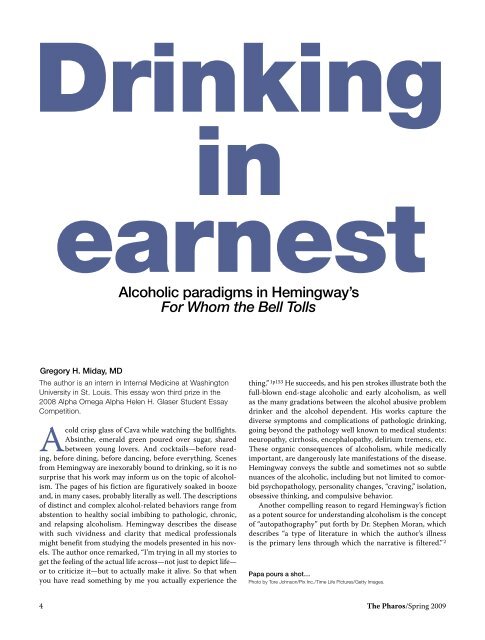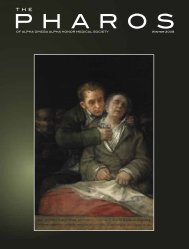4 - Alpha Omega Alpha
4 - Alpha Omega Alpha
4 - Alpha Omega Alpha
You also want an ePaper? Increase the reach of your titles
YUMPU automatically turns print PDFs into web optimized ePapers that Google loves.
Drinking<br />
in<br />
earnest<br />
Gregory H. Miday, MD<br />
Alcoholic paradigms in Hemingway’s<br />
For Whom the Bell Tolls<br />
The author is an intern in Internal Medicine at Washington<br />
University in St. Louis. This essay won third prize in the<br />
2008 <strong>Alpha</strong> <strong>Omega</strong> <strong>Alpha</strong> Helen H. Glaser Student Essay<br />
Competition.<br />
A<br />
cold crisp glass of Cava while watching the bullfights.<br />
Absinthe, emerald green poured over sugar, shared<br />
between young lovers. And cocktails—before reading,<br />
before dining, before dancing, before everything. Scenes<br />
from Hemingway are inexorably bound to drinking, so it is no<br />
surprise that his work may inform us on the topic of alcoholism.<br />
The pages of his fiction are figuratively soaked in booze<br />
and, in many cases, probably literally as well. The descriptions<br />
of distinct and complex alcohol- related behaviors range from<br />
abstention to healthy social imbibing to pathologic, chronic,<br />
and relapsing alcoholism. Hemingway describes the disease<br />
with such vividness and clarity that medical professionals<br />
might benefit from studying the models presented in his novels.<br />
The author once remarked, “I’m trying in all my stories to<br />
get the feeling of the actual life across—not just to depict life—<br />
or to criticize it—but to actually make it alive. So that when<br />
you have read something by me you actually experience the<br />
thing.” 1p153 He succeeds, and his pen strokes illustrate both the<br />
full-blown end-stage alcoholic and early alcoholism, as well<br />
as the many gradations between the alcohol abusive problem<br />
drinker and the alcohol dependent. His works capture the<br />
diverse symptoms and complications of pathologic drinking,<br />
going beyond the pathology well known to medical students:<br />
neuropathy, cirrhosis, encephalopathy, delirium tremens, etc.<br />
These organic consequences of alcoholism, while medically<br />
important, are dangerously late manifestations of the disease.<br />
Hemingway conveys the subtle and sometimes not so subtle<br />
nuances of the alcoholic, including but not limited to comorbid<br />
psychopathology, personality changes, “craving,” isolation,<br />
obsessive thinking, and compulsive behavior.<br />
Another compelling reason to regard Hemingway’s fiction<br />
as a potent source for understanding alcoholism is the concept<br />
of “autopathography” put forth by Dr. Stephen Moran, which<br />
describes “a type of literature in which the author’s illness<br />
is the primary lens through which the narrative is filtered.” 2<br />
Papa pours a shot…<br />
Photo by Tore Johnson/Pix Inc./Time Life Pictures/Getty Images.<br />
4 The Pharos/Spring 2009














